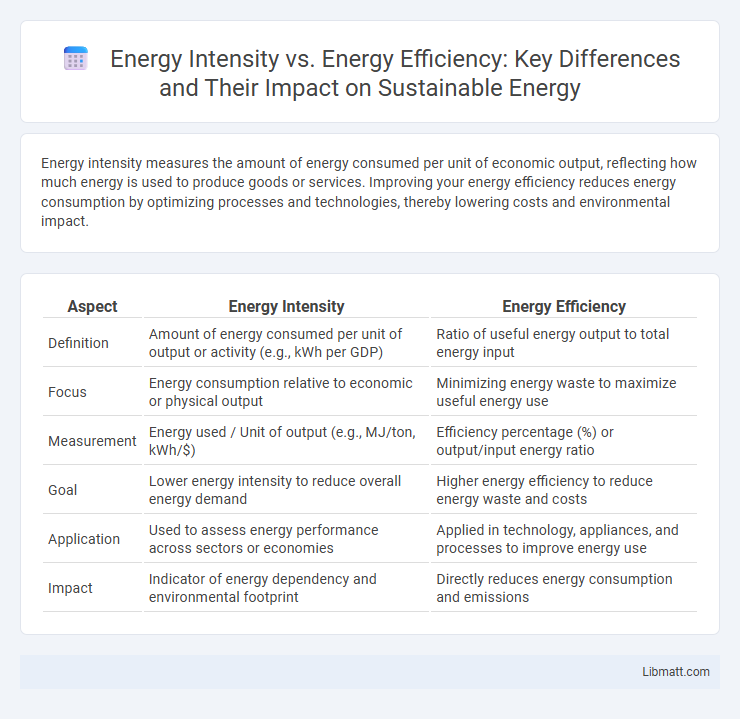Energy intensity measures the amount of energy consumed per unit of economic output, reflecting how much energy is used to produce goods or services. Improving your energy efficiency reduces energy consumption by optimizing processes and technologies, thereby lowering costs and environmental impact.
Table of Comparison
| Aspect | Energy Intensity | Energy Efficiency |
|---|---|---|
| Definition | Amount of energy consumed per unit of output or activity (e.g., kWh per GDP) | Ratio of useful energy output to total energy input |
| Focus | Energy consumption relative to economic or physical output | Minimizing energy waste to maximize useful energy use |
| Measurement | Energy used / Unit of output (e.g., MJ/ton, kWh/$) | Efficiency percentage (%) or output/input energy ratio |
| Goal | Lower energy intensity to reduce overall energy demand | Higher energy efficiency to reduce energy waste and costs |
| Application | Used to assess energy performance across sectors or economies | Applied in technology, appliances, and processes to improve energy use |
| Impact | Indicator of energy dependency and environmental footprint | Directly reduces energy consumption and emissions |
Understanding Energy Intensity and Energy Efficiency
Energy intensity measures the amount of energy consumed per unit of output, reflecting how much energy is used to produce goods or services within an economy or facility. Energy efficiency, on the other hand, focuses on reducing energy use while maintaining the same level of output, enhancing performance without compromising productivity. Understanding the distinction between these two concepts helps you identify opportunities to lower energy consumption and costs through targeted improvements in technology and processes.
Key Differences Between Energy Intensity and Energy Efficiency
Energy intensity measures the amount of energy consumed per unit of output, such as energy used per GDP dollar or production unit, highlighting how energy-demanding an activity or economy is. Energy efficiency refers to using less energy to perform the same task, meaning optimizing processes or technologies to reduce energy waste. Understanding the key differences between these concepts helps you identify whether improvements come from reducing overall energy use relative to output (energy intensity) or from enhancing the effectiveness of energy consumption in specific applications (energy efficiency).
Measuring Energy Intensity: Metrics and Methods
Measuring energy intensity involves analyzing the amount of energy consumed per unit of output, such as GDP or product volume, using metrics like energy use per dollar of GDP or per ton of manufactured goods. Common methods include benchmarking, energy audits, and statistical analysis of energy consumption data across sectors to identify trends and efficiency gaps. Enhancing your understanding of these metrics enables targeted improvements in energy use and supports more efficient resource management.
Evaluating Energy Efficiency: Standards and Benchmarks
Evaluating energy efficiency involves comparing actual energy consumption against established standards and benchmarks that account for system performance and operational conditions. Energy intensity measures the amount of energy used per unit of output, but true energy efficiency assessment requires understanding how well energy input is converted into useful work relative to these standards. You can optimize energy management by regularly benchmarking your processes to industry averages and regulatory guidelines, ensuring continuous improvement and cost savings.
Factors Influencing Energy Intensity
Energy intensity depends on factors such as the industrial structure, energy sources, technology level, and economic output efficiency within a region or country. High energy intensity often indicates energy-heavy industries or outdated technologies, while low energy intensity reflects efficient energy use and advanced infrastructure. Urbanization, climate conditions, and energy prices also significantly influence energy intensity by shaping consumption patterns and operational demands.
Strategies to Improve Energy Efficiency
Strategies to improve energy efficiency involve upgrading insulation materials, implementing advanced HVAC systems, and adopting energy-efficient lighting such as LEDs. Utilizing smart energy management systems optimizes real-time energy consumption, reducing overall intensity in industrial and commercial sectors. Incorporating renewable energy sources and regular maintenance of equipment also significantly enhance energy performance and lower energy intensity across applications.
Impact of Energy Intensity on Economic Growth
Energy intensity measures the amount of energy consumed per unit of economic output, serving as a critical indicator of how efficiently an economy uses energy to generate wealth. A decrease in energy intensity typically signifies improvements in energy efficiency and technological advancements, which can lead to sustained economic growth by lowering costs and enhancing productivity. High energy intensity, often linked to resource-heavy industries, can limit economic expansion due to increased energy costs and environmental constraints.
The Role of Policy in Enhancing Energy Efficiency
Energy intensity measures the amount of energy consumed per unit of economic output, while energy efficiency refers to using less energy to provide the same service or output. Policy plays a crucial role in enhancing energy efficiency by setting regulatory standards, incentivizing investments in energy-saving technologies, and promoting behavioral changes that reduce energy use. Your commitment to adopting policy-driven energy efficiency measures can significantly lower energy consumption and contribute to sustainable economic growth.
Case Studies: Success Stories and Lessons Learned
Case studies reveal that improving energy intensity, measured as energy consumption per unit of output, is key to boosting overall energy efficiency in industries like manufacturing and transportation. Success stories from companies adopting advanced technologies and data-driven energy management demonstrate significant cost savings and reduced carbon footprints. Lessons learned emphasize the importance of continuous monitoring and integrating renewable energy sources to sustain long-term efficiency gains.
Future Trends in Energy Efficiency and Energy Intensity
Advancements in smart technologies and renewable energy integration are driving significant improvements in both energy intensity and energy efficiency, reducing the amount of energy consumed per unit of output. Future trends indicate a shift towards more data-driven energy management systems that optimize energy use in real time, enhancing overall efficiency while minimizing environmental impact. Your adoption of these innovations will be pivotal in achieving sustainable growth and lowering carbon footprints across industries.
Energy intensity vs Energy efficiency Infographic

 libmatt.com
libmatt.com